Menus

r-photography.info

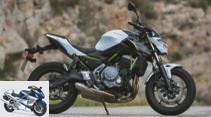
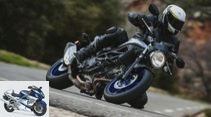
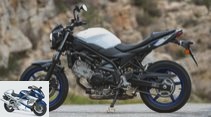
25th photos
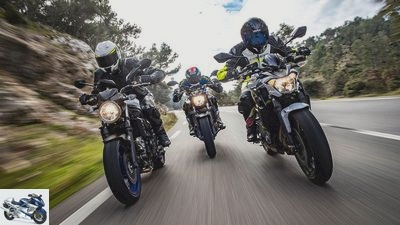
r-photography.info
1/25
The season is just around the corner, the drill sergeant is calling for roll call. With less than 200 kilograms of full tank and athletic performance on this side of the anabolic-pushed 200 hp
Suzuki’s SV 650 and Yamaha’s MT-07 the fitness check. There you will meet the new Kawasaki Z 650 with a sharpened body mass index.
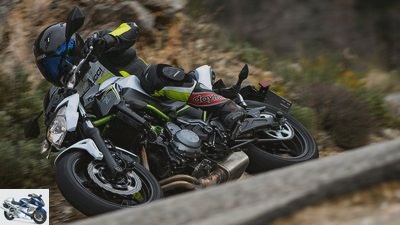
r-photography.info
2/25
The slimming program made the Z 650 unusually light – good for weird fun moments.
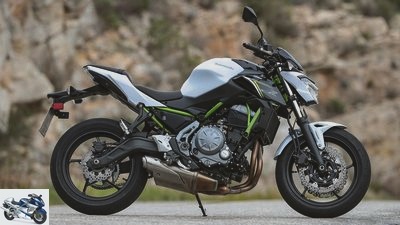
r-photography.info
3/25
The slim ER-6n became the slim Z 650.
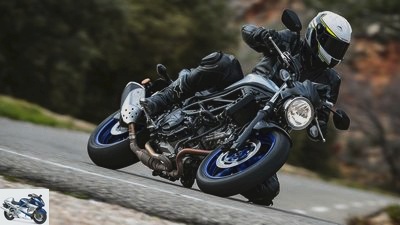
r-photography.info
4/25
The SV 650 can turn corners quickly and neatly. However, the test copy demands unusually high steering forces.
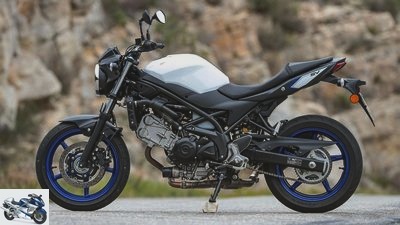
r-photography.info
5/25
With the Suzuki, form follows function, sobriety is the key.

r-photography.info
6/25
The MT-07 sweeps around corners lightly and with very good steering behavior, only more lean angle would be desirable.
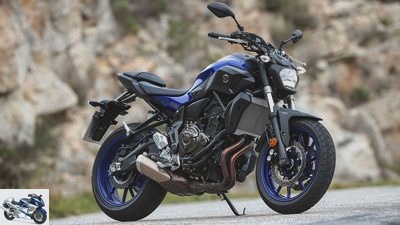
r-photography.info
7/25
With a full tank of 184 kilos, the MT-07 is the lightweight of the trio.
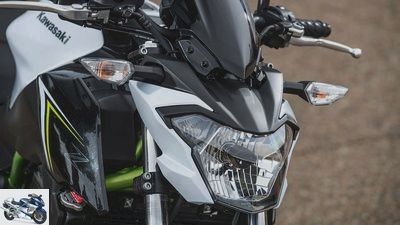
r-photography.info
8/25
Z 650 means jaggedness, it starts with the headlight.

r-photography.info
9/25
Dare to use more front silencers: Virtually no muffler means a lot of volume in front of it.
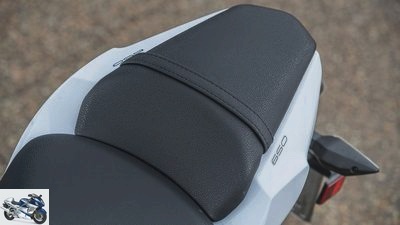
r-photography.info
10/25
Scarce upholstery on the not too narrow rear, no great pleasure for the pillion passenger.

r-photography.info
11/25
Unique selling point in this comparison: adjustable clutch lever.
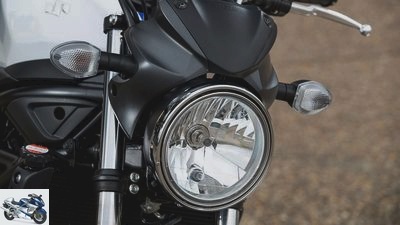
r-photography.info
12/25
Classic motorcycle design serves the front of the SV with the round light dispenser.
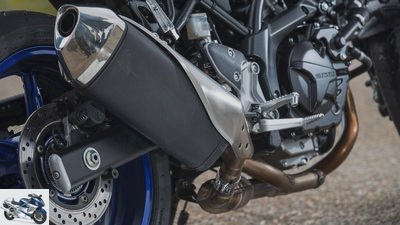
r-photography.info
13/25
Again, the SV is doing the classic thing, dampening the noise without a bread box under the engine.
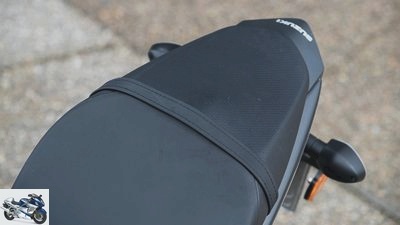
r-photography.info
14/25
This is how it works better: The SV has a suitable place for passengers.

r-photography.info
15/25
Not good: The SV brakes require a lot of manual force and should be more powerful.
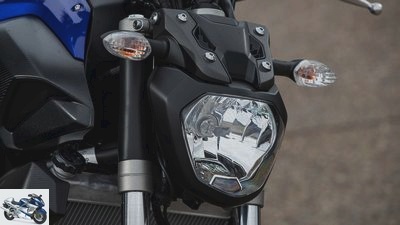
r-photography.info
16/25
The MT-07 looks futuristic, the headlight fits tightly between the fork.

r-photography.info
17/25
A little less front silencer, a little more muffler: This is how it looks with the MT.

r-photography.info
18/25
The pillion on the MT-07 is even more unstable than on the Z 650.
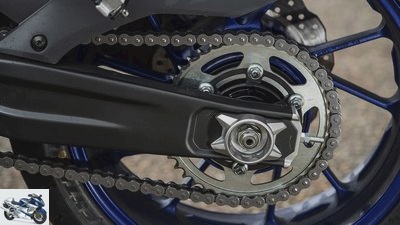
r-photography.info
19/25
Cheap doesn’t have to look cheap, as the Yamaha rear axle mount proves.
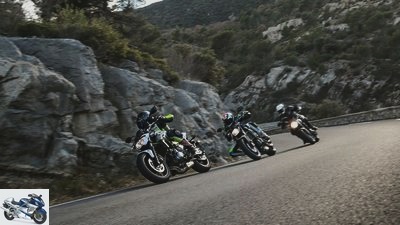
r-photography.info
20/25
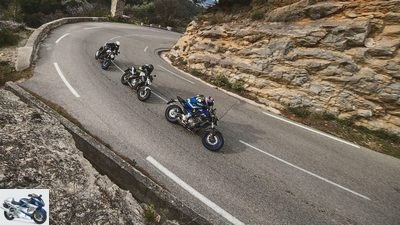
r-photography.info
21/25
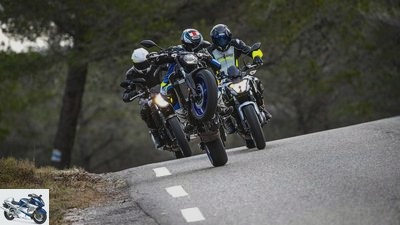
r-photography.info
22/25
Only for the picture on the road solo, the measurements were made with a pillion passenger.
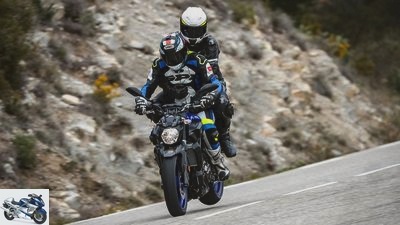
r-photography.info
23/25
Load test at the load limit of the MT.

r-photography.info
24/25
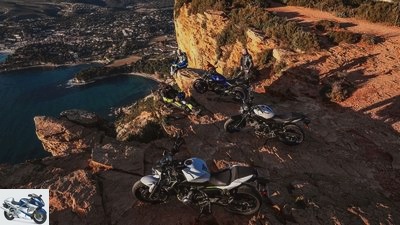
r-photography.info
25/25
Yamaha MT-07, Kawasaki Z 650 and Suzuki SV 650 in the test
Mid-range naked bikes
With less than 200 kilograms full of fuel and athletic performance, the Suzuki SV 650 and Yamaha MT-07 face the comparison test with the Kawasaki Z 650 with a sharpened body mass index.
Newton already knew: force is mass multiplied by acceleration. When it comes to power, the test trio of Kawasaki Z 650 (68 hp at 8000 rpm), Suzuki SV 650 (76 hp at 8500 rpm) and Yamaha MT-07 (75 HP at 9000 / min) pleasantly usable food in the wellness area, which is good for sporty propulsion. Mainly because they put a smile on the face of the drill sergeant as head minder over this test when going to the scales – keyword mass. The inspector likes it easy. The magic limit is 200 kilograms. All stay below, the hardworking points fly into the music book. The Z 650 deserves special praise. Because: At the last cross-brand fitness check (MOTORRAD 11/2016), the predecessor ER-6n let the weight meter’s pointer fidget just before the 210 kilogram mark. A strict diet was on the program over the winter. Low carb and a lot of exercise add up to 188 kilograms with the Z 650. A great development, but the sports coach straight away adjusts the situation: The Z 650 is finally where the others have been in recent years. Point.
Buy complete article
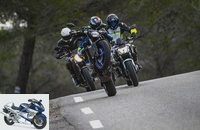
Yamaha MT-07, Kawasaki Z 650 and Suzuki SV 650 in the test
Mid-range naked bikes
Yamaha now adorns the Kawasaki with a tight tubular mesh frame. That should only weigh 15 kilograms. Taken in and of itself, this is not a top value, as the fitness officer also knows. But before that, the engine of the predecessor ER-6n was enclosed in a steel frame that, according to Kawasaki, weighed 25 kilos. Uff. That’s a hell of a lot. Together with slimming measures on the wheels, the brake system, the engine and the swing arm, the rolls of fat tumbled, adding up to a minus of 20 kilograms. This was only possible because the ER-6n was solidly built in some places, let’s call it. Nonetheless, the drill capo thinks positively and therefore holds fast: The less baby fat brings the Z 650 within striking distance of the lightweight champ of this class, the MT-07. It takes the coming season under the wheels with the current Euro 4 update. In other words: Equipped with side reflectors, an exhaust system with a larger catalytic converter and an adapted wiring harness for onboard diagnosis – and yet the MT-07 should still weigh only 184 kilograms. Surely a few extra pounds crept in? The Yamaha must immediately be on the scales to find the truth. It reports 184 kilos with a full tank and not a tiny bit more. The drill sergeant’s eyebrows rise in satisfaction. The Suzuki SV 650 doesn’t get that much adulation. At 199 kilograms, she scurries just under the 200 kilogram bar.
As a connoisseur of the matter, the fitness watchdog does not immediately give a ruffle, after all, the heart of the Suzuki beats in the right V2 rhythm. One cylinder at the front, one at the back, that adds up to a housing plus the head, innards and more weight than the other two, which are two-cylinder in-line. Not so bad if the heart is in top shape from the cardiological point of view. The motors start for the stress ECG.
The Kawasaki makes the start. With a slightly increased resting heart rate, the parallel twin bubbles to itself. Its data sheet promises more midrange power than the ER-6n, but also a power drop of four hp. The gear wheels of the first gear slide smoothly into each other, the clutch with assist and anti-hopping function disengages with the force of a finger. The fitness checker is also happy to take note of this. However, he also notices that the Z 650 jerks slightly when transitioning from pushing to load operation. Does this affect the acceleration? The sprint test will show. The Kawa flies away, hissing over the 100 km / h mark after 3.9 seconds. A scrutinizing look at the competition immediately reveals that the others cannot do it better in the range of a tenth. A stalemate at an appropriate level. But the two-cylinder continues to run, exceeding the 140 mark after 7.3 seconds. Again, the new Z 650 is on par with the Suzuki SV 650, only the MT-07 masters this test faster, requiring only 6.9 seconds.
The drill sergeant is enthusiastic about this performance of the three and the slight advantages for the Yamaha. As a strict inspector, however, he does not fail to notice that the MT-07 is capricious when changing gears quickly. The gearbox shifts hard, the clutch can be operated more easily than on the Suzuki, but it sometimes grabs. Where there is a lot of light, the shadow is sometimes not too far away.
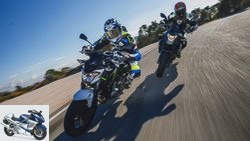
Naked bike
Kawasaki Z 650 and Kawasaki ER-6n in comparison test
Working class heroes
read more
The Yamaha wants to eradicate this criticism immediately, the pull-through test should put it back in the right light. Firmly believing in her own superiority, she sprints from 60 to 100 km / h in top gear and is amazed to discover that the Z 650 outstrips her. After 3.8 seconds, the twin from Akashi finished the test, the MT-07 needs 4.0 seconds more. The Suzuki lines up behind with another six tenths on the clock. The order does not change up to 140 km / h. The prevailing superiority of the Yamaha to date is gone. At least apparently, because up to 180 km / h the values are reversed. The Kawasaki has to let the Suzuki go by alongside the Yamaha.
So far so good. But isn’t all of this just theoretical odds and ends, an academic consideration for the busybody? Yes and no, interjects the drill officer. Yes, because in real life with the lively two-cylinder engines, nobody always chugs around in sixth gear. And no, because the sprint and pull-through values allow conclusions to be drawn about everyday experiences.
Now you can see what they look like. The head minder closes both eyes, the three of them are allowed to let off steam for a few moments beyond all measurement specifications. The carbohydrate stores are packed full of energy bars based on 95 octane, the horsepower of the engines is now given free rein.
The Yamaha comes out of the speed cellar casually, wipes through the entire speed range with joy, knows no stuck or dry spells. The crossplane engine gets the best out of a good 40 cm³ more displacement. Despite overall
the gear connections fit ideally in the Winkelwerk. Here, where gears two to four are primarily used for committed curve dancing, the Yamaha always delivers the right boost, has a good mood unit par excellence. The Kawasaki follows closely when the speed is right. Its engine pulsates like a tractor at low revs. If the revs do not rise above 5000 rpm, the Yamaha trainer always sees the Z 650 in full format in the rearview mirror. But as soon as it goes beyond that, which happens quickly because of the Z 650’s relatively short gear ratio, which is precisely selected for top speed, the gap quickly widens.
Then the Kawa-Twin runs beyond its maximum torque and has to turn. And it suffers from it – as with the pull-through measurements above – a little. The Nm high plateau is a thing of the past. In addition, the performance curve of the Z 650 is the first to drop again. While Yamaha and Suzuki are also allowed to cheer in five digits at the top, on the Kawasaki the lightning bolt in the cockpit warns of the next gear shift from 8000 revs. At 9500 rpm the speed limit finally falls.
Frenzy, the fitness supervisor seems to be calling from afar. But that’s not true, because this admittedly high speed range is used again and again with a fast, but by no means excessively sporty driving style. Also because it is fun to use the potential of the three, because you can enjoy it without fear even without electronic helpers.
When discovering great curve combinations, the Suzuki willingly plays along. Your V2 fits right between the Kawa and the Yamaha. At the bottom it lacks a little acceleration, as the Z 650 offers, but from 3500 rpm the engine gets a lot of life, which doesn’t ebb up to the top. In the speed dance it doesn’t come close to the liveliness with which the Yamaha sweeps from bottom to top.
But that is not the only reason why the Suzuki cannot follow the Yamaha when it comes to back and forth on the bends. Rather, the chassis of this test machine is a mystery. The fork and shock absorber act with a lot of damping. That brings stability, but on waves and bumps, there is a lack of sensitivity and good responsiveness. In addition, the tires (Dunlop Qualifier) want to be warmed up properly on the rims in order to adhere properly. They convey little confidence when cold and also stand up when braking in bends. Or to put it another way: The interplay between the grip on the front brake and the hardening of the front makes turning into an act of strength. Nothing works casually. All previously tested Euro 4-SV-650s from Suzuki did not attract attention because of their playful handling, but they were far from this stubborn driving behavior. A Monday model appeared when comparing. The subject of braking on the Suzuki itself is ambivalent: the floating calipers at the front require the whole hand for powerful deceleration, the dosage falls by the wayside, the effect is poor. Only with ABS does the SV move a little forward. The smooth control behavior and the stability of the fork, which can be assessed as positive under this aspect, help you to stop worrying along the limit of the grip.
The chassis is not a highlight on the MT-07 either. With its very comfortable coordination of fork and shock absorber, it allows a lot of movement. Good for comfort, bad for stability. Heavy drivers are particularly bothered by it, while lighter drivers up to around 75 kilograms are more likely to cope with it. However, you have to give the chassis the fact that despite the ups and downs, it rarely breaks through completely, always has a decent progression cushion ready for the last centimeters of spring travel and shines with good response behavior. And because the MT-07 has no weaknesses when it comes to brakes thanks to its radially hinged four-piston calipers, its overall package is something like a guarantee of driving pleasure in the thicket of corners. Which is also due to the fact that, despite slippers in 120 and 180 format – Kawa and Suzuki are satisfied with 120 and 160 sizes – none of the others can fool them. The only point of criticism: the ABS control behavior. Roughly, interval follows interval, the rear wheel can easily lose contact with the ground – but harmlessly.
The Z 650 can do better than that. Their floating saddles bite properly and easily dosed into the wave discs, and the ABS convinces with its foolproof control behavior. Similar to the MT-07, its fork is softly tuned, while the shock absorber works more trampling and does not react very sensitively to edges. Bumps and quick changes in lean angle can cause unrest in the motorcycle. What remains a positive aspect, however, is the greatly improved handiness of the Z 650 compared to the ER-6n. The Kawasaki now zooms through corners with unusual ease.
The drill sergeant calls out, from now on common sense is the trump card again, the three of them have to endure the endurance test and are supposed to do meters in a way that saves strength. A marathon would be too short as a challenge, it has to be 100 kilometers. And please wipe them under the wheels with brisk swing and in high gear so that the noble juice in the tank is handled as effectively as possible. A good two hours later, Kawasaki, Suzuki and Yamaha are back in front of the coach. He immediately checks the basic condition based on consumption. His conclusion is: all in good condition. With 4.0 liters for the 100 km distance, the Z 650 sips the most from the 15-liter supply stored further up. The short translation may be responsible for the small surcharge compared to the other two, because with 3.9 liters for the Yamaha and 3.7 liters for the Suzuki, they use fuel more efficiently. In terms of ranges, the differences due to the tank sizes (Yamaha 14 liters, Suzuki 13.8 liters) are again small. The condition of the Z 650 is sufficient for 375 kilometers in a row, the SV 650 comes to a halt two kilometers earlier, the MT-07 masters 359 kilometers without a visit to the trusted gas station attendant.
Can such distances be mastered at all without pinching and pinching somewhere? The drill sergeant knows that only a comfortable trainer is a good trainer, so the middle class nakeds have to bed their passengers comfortably. Admittedly, it depends to a certain extent on the size of the driver. Hence the inspector’s recommendation in length. With a distance of 470 millimeters between the rests and the seat, the Z 650 comes to the fore as a reference for shorter contemporaries. This is also due to the relatively tight cushion, which in comparison offers the least amount of space to slide backwards. There’s more of that with the MT-07, and the distance between notches and upholstery is more generous at 485 millimeters. Taller people are only bothered by the small distance between the bench and the handlebars. You can get it from Suzuki. Another thing that tallers like: she has 47 centimeters between the bench and the rests, and thanks to the one-piece design, her wide bench offers the most space to the rear. The evaluation is therefore clear. Little changes in the order for passengers in the second row. The SV 650 masters this task with the most open knee angle and plenty of space for the pillion rider, while the other two are less tight. Whereby the MT-07 with just 171 kilos allowed payload isn’t allowed to pack much on it anyway. The fitness checker does not like to see so little load capacity when tearing. Mainly because the Z 650 with 199 and the SV 650 with a full 221 kilograms have a lot more reserves.
The fitness inspector has noted it down and is preparing the final assessment. Spurting ability, endurance, he only finds a few really harsh points of criticism. They take a back seat at the latest when the final test is due: the cost-performance vote. Kawasaki wants 6695 euros for the Z 650, the Suzuki SV 650 is available in plain black for 6395 euros, with Yamaha 6695 euros are also due for the change of owner. As a result, in relation to the counters achieved in the 1000-point evaluation, this makes two grade one with a comma. The MT-07 even has a straight 1. It really doesn’t get any better, fitness check passed with flying colors.
MOTORCYCLE test result
1. Yamaha MT-07
After the Euro 4 update it is the same as before: The MT-07 has lost none of its positive properties. Your engine turns on, the brakes bite hard. Despite criticism of the shock absorber: Nowhere else is there more motorcycle for the money.
2. Suzuki SV 650
At the last meeting, the SV 650 beat the MT-07 with its balance. The current test machine lacks that, especially with the chassis, which is unusually stubborn. Nevertheless, it is good for many points.
3. Kawasaki Z 650
Only third place and still a positive conclusion: The Z 650 is the much better ER-6n. It noticeably shortens the gap to the competition and has removed old weaknesses such as sluggish handling. For this, the pillion must now suffer more than before.
Price comparison of the three mid-range naked bikes
Used Kawasaki Z 650, Suzuki SV 650 and Yamaha MT-07 in Germany
The winner for the price-performance ratio has already been chosen. But on the used motorcycle exchange, the Kawasaki Z 650, the Suzuki SV 650 and the Yamaha MT-07 face each other in a direct price comparison. In this competition, motorcycles in top condition at low prices match each other and turn the price-performance ratio upside down again: Used Kawasaki Z 650, Suzuki SV 650 and Yamaha MT-07 in Germany
Related articles
-
Comparison test Suzuki SV 650, Honda CB 650 F, Kawasaki ER-6n, Yamaha MT-07
www.bilski-fotografie.de 34 photos www.bilski-fotografie.de 1/34 They are the hottest contenders among the mid-range naked bikes….
-
Jahn Comparison test Powercruiser Kawasaki VN 2000, Suzuki Intruder M 1800 R, Yamaha XV 1900 Midnight Star Punchtime Nobody distributes more displacement…
-
Yamaha MT-07, Kawasaki ER-6, Suzuki Gladius 650 and Ducati Monster in the test
Jahn 39 pictures Jahn 1/39 Where I am is in front – the MT-07 is addicted to curves. Jahn 2/39 Less saved: At least the fork can be …
-
Kawasaki Z 800, Yamaha MT-09 and BMW F 800 R in a comparison test
35 photos 1/35 The center is no longer where it used to be. Because bikes with displacements around 800 cm³…
-
Honda CBF 600, Kawasaki ER-6n, Suzuki Gladius 650 and Yamaha XJ6
Artist Honda CBF 600, Kawasaki ER-6n, Suzuki Gladius 650 and Yamaha XJ6 Comparison test all-rounder Looking for a partner in the world of all-rounders?…
-
BMW F 800 R, Kawasaki Z 800, MV Agusta Brutale 800 and Yamaha FZ8 in the test
Jahn 29 photos Jahn 1/29 A comparison of four 800 class motorcycles: BMW F 800 R, Kawasaki Z 800, MV Agusta Brutale 800 and Yamaha FZ8. Jahn 2/29 Like…
-
Honda Hornet 600, Kawasaki Z 750, Suzuki GSR 600, Yamaha FZ6
Jahn Honda Hornet 600, Kawasaki Z 750, Suzuki GSR 600, Yamaha FZ6 Comparison test all-rounder Do you do a job in a high position? as the darling of the…
-
Comparison test touring enduro bikes: Honda Transalp, Kawasaki Versys, Suzuki V-Strom 650
Jahn Comparison test of travel enduro bikes: Honda Transalp, Kawasaki Versys, Suzuki V-Strom 650 Always along the wall Travel enduro doesn’t necessarily…
-
KTM 690 Duke and Yamaha MT-07 in comparison test
www.factstudio.de 25th photos www.factstudio.de 1/25 Power on the crankshaft. Measurements on the Dynojet roller test stand 250, corrected according to…
-
Comparison test Honda CBR 500 R, Kawasaki Ninja 400, KTM RC 390, Yamaha YZF-R3
r-photography.info 29 photos r-photography.info 1/29 Honda CBR 500 R, Kawasaki Ninja 400, KTM RC 390 and Yamaha YZF-R3 in comparison test….